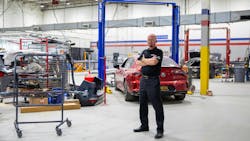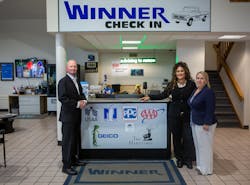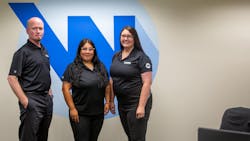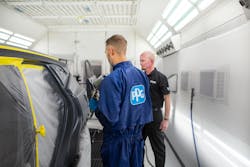For many, the morning shower can provide a quiet place of reflection. For Jon Sommers, it’s also a time to plan out his day for efficiency. As a flat-rate mechanical technician for 15 years at Winner Premier Collision Center in Wilmington, Delaware, Jon Sommers would run through in his mind the jobs he knew he’d be working on that day after having done end-of-day planning the prior day to stage his work.
“After taking the body off, I’m going to roll the frame over here and get the engine and trans out,” he recalls thinking as he could practically see himself as an observer carrying out these tasks.
He’s now the director of that body shop and the one in Dover as part of the Winner Automotive Group of Audi, Chevrolet, Ford, Hyundai, Subaru, and Volkswagen brands in Wilmington and Dover. But Sommers has carried over that “shower thoughts planning” mindset each morning. That might entail the mundane, such as reminding staff to turn in their hours for payroll or planning for the morning production meeting, or it may be preparing for an audit for one of the shop’s OEM certifications.
As he’s applied that analytical planning mindset to his management role, Sommers is quick to share the praise with the managers he leads, and says he’s humbled in being named the 2025 winner of the FenderBender Award. He was tapped to turn around the shop about three and a half years ago.
Making the Transition to Management
At that time, after the body shop manager quit, Thomas Mihok was tasked with leading the Winner Premier shop in Wilmington, but he lacked body shop experience. Mihok, who at the time was general manager of Audi Wilmington — one of the dealerships in the Winner Automotive Group of which he is now executive general manager — selected Sommers, who had worked as a mechanical technician in the body shop for 15 years.
Through an interview process of the shop’s estimators and fellow technicians, Sommers says, he “essentially got voted in” as interim manager. “My name came up repeatedly. I didn’t throw my own hat in the ring, so to speak.”
For Mihok, the choice was obvious.
“I immediately realized that Jon had a grasp on the overall challenges that were hurting the business, and he displayed a passion for the business I hadn't seen in an employee for years,” wrote Mihok in his nomination of Sommers for the Award.
While the search at the time was still on for a new body shop manager, Mihok and Sommers spoke for hours each day about where changes were needed and where the shop was successful.
“Jon took on many leadership responsibilities without anyone asking,” Mihok says. “He truly ‘picked up the ball and ran with it.’ Why? Because he had spent 15 years there and wanted nothing more than to do quality work for people who cared. Jon, the office manager, and I kept every employee, adjusted pay plans, and essentially saved that business from failing after four years of poor leadership post-COVID.”
Sommers recalls the situation as being an emergency. “There was no time to sit and think through the pros and cons or weigh out the decision. At that point I had worked at Premier for 15 years, and I looked at it like this: ‘If your shop is on fire, do you take the time to think about what to do, or do you jump in and try to put it out?’ I jumped in.”
Transitioning from technician to manager took about six months, Sommers says.
“I would change clothes after our morning meeting and jump in on the shop floor to keep everything moving. I still jump in when I can, like this morning I was helping one of the technicians in our Dover location with a difficult alignment. I don't want to lose touch with the actual product and service we provide. I frequently test drive our jobs as part of the QC process; it helps keep me engaged.”
Mihok says Sommers has worked tirelessly to bring up the shop to his vision and standard of quality, and a year later accepted his offer to be the body shop manager a year later.
Another promotion followed; as of the beginning of this year, Mihok named Sommers body shop director, adding the Dover collision repair center to his responsibilities and implementing the same operational improvements he did in Wilmington.
Bitten by the Car Bug at An Early Age
Sommers has always been fascinated with cars.
“As a kid, I saved up money earned from doing small chores for family and neighbors, and I purchased classified publications from the local news stand, specifically to read about the cars for sale. I was a huge fan of Hot Rod magazine, Car Craft, Super Chevy, Minitruckin,’ etc. I would call my level of interest a borderline obsession.”
Even before he had a driver’s license, his summer job was at a local garage learning basic mechanical repairs, followed by driving a tow truck after school and on the weekends, which was his first exposure to the collision repair industry, he says. After high school, he graduated from Nashville Auto Diesel College’s collision repair program in 2001.
“While I was formally trained in all aspects of the process, I always gravitated toward mechanical/electrical repairs and diagnostics,” he says. As mechanical technician at the body shop, he specialized in frame replacements, dash-pulls, electrical wiring, metal-straightening, and what he would classify as “B-tech work.”
Mihok praises Sommers for the number of processes he’s brought to the two shops on the front end with estimators and the back end with the production team as he performs the dual roles of body shop director and production manager.
“For the last three years, he has worked non-stop, including evenings and weekends, to bring the body shop up to his vision and quality standard,” he says.
Implementing Process Improvements
The first step to improvement is to define what the problem is, notes Sommers.
“It's the scientific method to problem-solving. Not all shops have the same procedural issues -and I do not believe in a ‘one-size-fits all’ approach,” he says. “It is important to standardize some of the logistical processes between the stores (especially for my own sanity). I tend to perform whatever process I am working on a few times myself to better understand where things need to be tweaked.”
Sommers analyzed where processes needed improvement for each phase, from teardown and blueprinting through quality control and delivery. Then he standardized and wrote the procedure for each phase so that all staff, from technicians to writers and managers, were on the same page, as many of the staff were using their own processes used over the years from previous employers. After proving them at the Wilmington location, he brought them over to the Dover location.
“When you put together a process, you have to simplify everything enough so that it can be repeatable,” he says. “You don’t want it so complicated that we can’t remember and we’re skipping step 6 and step 8 half the time.”
In doing so, he’s also setting himself up to lighten his workload a bit by having pulled along Mellissa Cartwright, body shop manager at the Dover location, and Wendy Isham, office manager in Dover, and Gina Maxon, office manager in Wilmington, to being able to run daily operations without him.
“I said, ‘Guys, watch me do it for two months, and then I'm going to sort of start to hand the reins over for you guys to do it.’”
Such process improvements mean smoother operations, resulting in less stress, greater production efficiency, an 11.25% increase in sales in the past 3-1/2 years, and limiting waste, such as decreasing paint resprays by 60%.
Quality Control
Sommers has helped decrease comebacks and improved CSI by implementing a standardized and tight quality control process. This means numerous checks throughout the process, not just when the vehicle is on the “done row.” A single-page quality control sheet follows the vehicle throughout the process beginning at intake, such as, “Was unrelated prior damage photographed?” The refinish checklist includes details such as ensuring there is a good color match and there are no fisheyes or runs, seeminly simple details but ones that can be overlooked.
Sommers just started his new role as the Subaru Certified Collision program was making in-process QC checks mandatory, he says, and provided the framework for his own QC sheets. They are a big help, but ultimately, he says, the culture of the shop determines the quality of the finished work.
“Hire people with pride in their work. Manage expectations,” he says.
At the same time, the shop has increased net profit by 78%. Contributing to this is getting more than 100 hours out of a gallon of clearcoat (the shop uses PPG), up from 80 hours per gallon, by processes that limit waste and comebacks.
“Our paint shop knows we are watching the pours, and they want to be the best. A lot of this directly correlates to your head painter and their level of pride.”
Each technician is required to use the CCC mobile app, enabling on-the-spot updates and documentation.
“The more photos you have, the better documentation you have, and the more chances you have of getting paid for what you're doing,” he says.
It’s probably no surprise that a well-oiled machine also reduces friction in the repair process with customers. Winner also uses the text function available in CCC ONE to keep customers updated, along with phone calls.
“Remembering that this is about the people is a huge driver of success in this industry,” Sommers says. “Always try to empathize with the owner of the vehicle and be an advocate for them. We provide a service to a wide range of customers, with very different priorities.”
Sommers has reduced employee turnover, partly by hiring talented team members, he says, but also by listening to their concerns.
“It’s important to be accessible and let people know their concerns are valid and being heard.”
For Sommers, the processes help solidify teamwork at the shops.
“There is no such thing as a superstar technician, estimator, writer or director without the team behind them driving collective success,” he says. “Consistency is key. Slow is smooth, and smooth is fast.”
Mihok agrees. “I know I can rely on Jon to never let anything fall through the cracks. He has sacrificed a lot of time with his family to embrace his role and build out his team. It is because he is passionate about the industry that he stays so engaged. I’ve never met a manager who reads so much on their personal time about the collision repair business, statistics, and best practices. He truly wants to make it as frictionless as possible for clients and make their vehicle pre-incident quality.”
About the Author
Jay Sicht
Editor-in-Chief, FenderBender and ABRN
Jay Sicht is editor-in-chief of FenderBender and ABRN. He has worked in the automotive aftermarket for more than 29 years, including in a number of sales and technical support roles in paint/parts distribution and service/repair. He has a bachelor's degree in journalism from the University of Central Missouri with a minor in aviation, and as a writer and editor, he has covered all segments of the automotive aftermarket for more than 20 of those years, including formerly serving as editor-in-chief of Motor Age and Aftermarket Business World. Connect with him on LinkedIn.
Don't miss Jay's next article or podcast. Sign up for FenderBender Today's Collision Repair News and ABRN eNews here.




